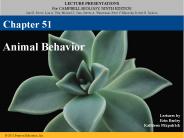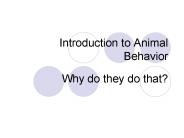Greylag PowerPoint PPT Presentations
All Time
Recommended
Title: PowerPoint Presentation - History of Animal Behaviour Author: Sergio Pellis Last modified by: Leanne Wehlage Created Date: 4/16/2003 12:14:28 AM
| PowerPoint PPT presentation | free to view
ANIMAL BEHAVIOR What is Behavior? Anything an animal does in response to a stimulus Stimulus: environmental change that directly influences an organism Example ...
| PowerPoint PPT presentation | free to download
Social Integration Recognition Process Mechanisms Male-female integration Parent-offspring integration Group integration
| PowerPoint PPT presentation | free to download
Chapter 3 The Process of Science: Studying Animal Behavior
| PowerPoint PPT presentation | free to view
A cardinal feeds minnows, which rose to the surface looking for food. During several weeks the bird fed them, probably because his nest had been destroyed. ...
| PowerPoint PPT presentation | free to view
QUICK ASSESSMENT 2. PLEASE BE SILENT. PLEASE DO NOT OPEN PAPERS YET ... RNA Viruses typical of bird guts. H5N1. 8 genes. PANDEMIC. FLU' VIRUSES. KEY MUTATIONS ...
| PowerPoint PPT presentation | free to view
Forestry and Bird Conservation in Ireland with special reference to Hen Harrier A presentation for: COFORD Council Land Availability Working Group (CCLAWG)
| PowerPoint PPT presentation | free to download
Unit 3 Respondent Conditioning Phylogenic Behavior Kinesis- relation between a stimulus and speed of movement irrespective of direction Wood louse Taxis relation ...
| PowerPoint PPT presentation | free to download
Chapter 3 Sanderling growth & behavioral development depend on genes ... 3.10 Nests of Polistes paper wasps contain odors that adhere to the bodies of the wasps ...
| PowerPoint PPT presentation | free to view
AP Bio Exam Review Ecology Unit
| PowerPoint PPT presentation | free to view
AP Bio Exam Review Ecology Unit
| PowerPoint PPT presentation | free to view
Selling an Idea or a Product
| PowerPoint PPT presentation | free to view
Innate behavior = behavior that appears without being taught or learned (inherited) ... Duckling and mother. Learned Behavior ...
| PowerPoint PPT presentation | free to view
The brain does not literally accumulate energy in any centers and nothing flows. ... This reaction gives rise to its opposite called the B state. ...
| PowerPoint PPT presentation | free to view
Chapter 51 Animal Behavior
| PowerPoint PPT presentation | free to view
Midterm Final Review Part I Types of Fermentation Alcohol fermentation Pyruvate Ethanol + CO2 Ex. bacteria, yeast Used in brewing, winemaking, baking Lactic acid ...
| PowerPoint PPT presentation | free to view
Taxis relation between stimulus and movement away from the stimulus ... vessels in skeletal muscles, galvanic skin response, pupilary dilation, etc. ...
| PowerPoint PPT presentation | free to view
Chapter 51 Animal Behavior
| PowerPoint PPT presentation | free to download
... fostered Galahs behave like Pink Cockatoos or Galahs? Rowley and Chapman ... Contact calls, wingbeat frequency, food choices resemble Pink Cockatoo behaviour ...
| PowerPoint PPT presentation | free to view
Introduction to Animal Behavior Why do they do that? Animals exhibit a great variety of rhythmic behavior patterns Circadian rhythms are patterns that are repeated ...
| PowerPoint PPT presentation | free to download
... developmental interaction Specialized Learning Memory formation to aid in finding food Clark s Nutcracker Clark s Nutcracker Whack cones of Whitebark ...
| PowerPoint PPT presentation | free to view
Example: cuckoo. Cuckoos: brood parasites. Lay their eggs in the nests of other species ... Fitness: advantage of host of recognising the cuckoo egg ...
| PowerPoint PPT presentation | free to view
1. To show how an animal simplifies the outside world by responding specifically ... The fly larvae burrow into and eat the cricket. ...
| PowerPoint PPT presentation | free to view
The survival of the tropical frog depends on the coloration and its instinct ... salivate in response to unrelated stimuli, such as light, tuning fork, and bell. ...
| PowerPoint PPT presentation | free to view
Epidemiological analysis, as part of surveillance programmes (study of risk ... not mainly in littoral, marine or other habitats ...
| PowerPoint PPT presentation | free to view
... positive and negative emotional scenes form the International Affective Picture ... Earhart, whom flying made her famous and disappearing (in 1937 after ...
| PowerPoint PPT presentation | free to view
DEVELOPMENTAL PSYCHOLOGY WEEK ONE What is developmental psychology? Influences on development Early socialisation WEEK TWO Development of attachments
| PowerPoint PPT presentation | free to view
Why do animals do what they do? Why do birds sing? How do sea turtles navigate the ocean to lay their eggs on the same beach where ...
| PowerPoint PPT presentation | free to view
Proximate E. imprinting I. Stimulus M. modal action pattern. Taxis F. fixed action pattern J. insight learning N. classical conditioning. Ethogram G. reflex K. ...
| PowerPoint PPT presentation | free to view
Proximate E. imprinting I. Stimulus M. modal action pattern ... The greylag goose returning its egg to the nest is a classic example of a __F__. ...
| PowerPoint PPT presentation | free to view






























